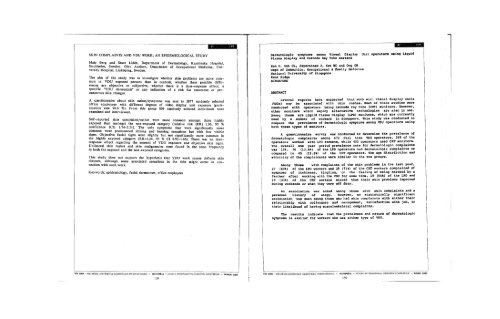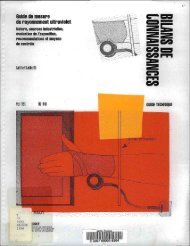CHANGES IN DISCOMFORTS DURING SIX YEARS OF VDT WORKVDUS IN BRAZIL: NEW TECHNOLOGIES IN AN OLD FRAMEWORKRoger Wibom and Ulf Bergqvist, Department of Neuromedicine, National Institute ofOccupational Health, Solna, Swe<strong>de</strong>n.Angelo dos Santos Soares, Informatic Department,Getulio Vargas - SSo Paulo, Brazil.FundaçâoThis investigation is part of a longitudinal study of office <strong>work</strong>ers in seven differentcompanies, aimed to elucidate possib<strong>le</strong> relationships between VDT <strong>work</strong> and adversehealth effects. In this part, changes in health prob<strong>le</strong>m status from 1981-82 to 1987-88 areconsi<strong>de</strong>red, in relation to changes in VDT <strong>work</strong> status.In 1981-82, 535 subjects respon<strong>de</strong>d to a questionnaire on various health prob<strong>le</strong>ms and<strong>work</strong> conditions. The same questionnaire was distributed in 1987-88 to those 353 subjectsstill availab<strong>le</strong>, 337 (95%) of whom respon<strong>de</strong>d.The percentage of each group (535 vs 337) who used VDTs in their <strong>work</strong> was 73% in1981-2 and 86% 1987-8. Concerning preva<strong>le</strong>nces of health effects, small overall increasesin eye discomforts (62% to 65%) and neck prob<strong>le</strong>ms (52% to 57%) and somewhat largerincreases in skin prob<strong>le</strong>ms (18% to 28%) were noted. Individual changes were noted to ahigher <strong>de</strong>gree - for examp<strong>le</strong>, eye prob<strong>le</strong>ms appeared for 14% of the 337 group anddisappeared in 12%, resulting in a small overall increase.The risk ratio, i e the risk of getting eye discomfort during this six-year period for thosewho <strong>work</strong>ed <strong>with</strong> VDTs in 1987-8 compared to those not <strong>work</strong>ing <strong>with</strong> VDTs in 1987-8was 1.9, regard<strong>le</strong>ss of whether they <strong>work</strong>ed <strong>with</strong> VDTs in 1981-2 or not. For skinprob<strong>le</strong>ms, the corresponding risk ratio was 1.3 and for neck prob<strong>le</strong>ms 0.71. The ratio inthe other direction, that is the chance of ceasing to have discomfort during this period forthose <strong>with</strong> vs those <strong>with</strong>out VDT <strong>work</strong> was 0.52 for eye discomforts and 1.4 for neckprob<strong>le</strong>ms. (For skin prob<strong>le</strong>ms, subjects in the non-VDT categories were too few.)Overall, risk ratios for 'current 'discomforts vs 'current' VDT <strong>work</strong> (calculated for eachperiod; 1981-2 and 1987-8) increased for eye discomforts, whereas changes were <strong>le</strong>ss forskin and neck prob<strong>le</strong>ms. Comparing discomforts in 1981-2 for those who remained in thestudy 1987-8 vs those who dropped out, no major differences were seen, for eyediscomforts the preva<strong>le</strong>nces were nearly i<strong>de</strong>ntical.The changes seen in various discomforts in relation to changes in VDT <strong>work</strong> do showconsistency <strong>with</strong> other findings in the total study; a prominent relationship between eyediscomfort and VDT <strong>work</strong>, a questionab<strong>le</strong> such for skin prob<strong>le</strong>ms, and no relationshipbetween neck prob<strong>le</strong>ms and VDT <strong>work</strong>.KEYWORDS: Discomfort changes, VDT <strong>work</strong> changes, eye discomfort, neck prob<strong>le</strong>ms,skin prob<strong>le</strong>ms.The aim of the study was to make a preliminary evaluation ofhow VDUs are being used here in Brazil, the Third World's Country that has the largest e<strong>le</strong>tronic market which is estimatedin US$ 8 billions.I surveyed 5 organizations (public and private) which use intensivelyVDUs. I ma<strong>de</strong> personal interviews, I visited the <strong>work</strong>places and I prepared a questionnaire which was answered by171 <strong>work</strong>ers (data-entry c<strong>le</strong>rks, te<strong>le</strong>phone operators, reserveagents). I also surveyed the largest Brazilian VDUs manufacturer.Brazilian VDUs, unfortunately, are not ergonomicaly <strong>de</strong>signed.46.9% do not have filter or hood to <strong>de</strong>f<strong>le</strong>ct glare and 25.2% donot know if the filter exists. Adjustments of: ang<strong>le</strong> of keyboard,height of screen, size of symbols, pressure of keys arenot avaiab<strong>le</strong>. The only possib<strong>le</strong> adjustments are contrast andintensity. Manufacturers do not know about the risks involved<strong>with</strong> radiation (ionizing and non-ionizing) and do not controlthis variab<strong>le</strong> in their production line.Ergonomie aspects of the <strong>work</strong>stations are not taken into account.Although we have quite good chairs, we do not have appropriatetab<strong>le</strong>s for VDU use. The only foot rest manufacturerstopped the production because there were no purchasers. Inevery <strong>work</strong>place, I could not observe the use of documenthol<strong>de</strong>r.The <strong>work</strong>ing time is the minimum of 30 hours a week. The wagesare very low, which make overtime and/or sometimes a secondjob very frequent. The <strong>work</strong> is e<strong>le</strong>tronically monitored.The consequences of this reality are an increasingly number of<strong>work</strong>ers <strong>with</strong> Repetition Strain Injuries (RSI).It was estimatedthat 30% of our data-entry c<strong>le</strong>rks has got tenosinovitls whichwas accepted as an occupational disor<strong>de</strong>r only in 1987. 68.4%complain about general tiredness, 61.4% about irritability and59.7% about headaches, which may indicate high <strong>le</strong>vel of stressprob<strong>le</strong>ms.KEYWORDS: Ergonomics, Work Organization, RSI,StressTEV 1989 — DEUXIÈME CONFÉRENCE SCIENTIFIQUE INTERNATIONALE • MONTRÉAL • SECOND INTERNATIONAL SCIENTIFIC CONFERENCE — WWDU 1989136TEV 1989 — DEUXIÈME CONFÉRENCE SCIENTIFIQUE IN TERNATIONALE • MONTRÉAL • SECOND INTERNATIONAL SCIENTIFIC CONFERENCE — WWDU 1989137
SKIN COMPLAINTS AND VDU WORK; AN EPIDEMIOLOGICAL STUDYMats Berg and Sture Lidén, Department of Dermatology, Karolinska Hospital,Stockholm, Swe<strong>de</strong>n. Olav Axelson, Department of Occupational Medicine, UniversityHospital, Linkôping, Swe<strong>de</strong>n.The aim of the study was to investigate whether skin prob<strong>le</strong>ms are more commonin VDU exposed persons than in controls, whether these possib<strong>le</strong> differencesare objective or subjective, whether there is a dose-response effect, aspecific "VDU <strong>de</strong>rmatosis" or any indication of a risk for cancerous or precancerousskin changes.A questionnaire about skin rashes/symptoms was sent to 3877 randomly se<strong>le</strong>ctedoffice employees <strong>with</strong> different <strong>de</strong>grees of vi<strong>de</strong>o <strong>display</strong> unit exposure (participationrate 96.6 %). From this group 809 randomly se<strong>le</strong>cted individuals wereexamined and interviewed.Self-reported skin complaints/rashes were more common amongst those highlyexposed than amongst the non-exposed category (relative risk (RR) 1.96, 95 %confi<strong>de</strong>nce (CI) 1.74-2.21). The only symptoms that were significantly morecommon were pronounced itching and burning sensations but <strong>with</strong> few visib<strong>le</strong>signs. Objective facial signs were slightly but not significantly more common inthe highly exposed category (RR=1.24, 95 % CI 0.93-1.66). There was no doseresponseeffect regarding the amount of VDU exposure and objective skin signs.Unilateral skin rashes and skin malignancies were found in the same frequencyin both the exposed and the non-exposed categories.This study does not support the hypothesis that yDU <strong>work</strong> causes <strong>de</strong>finite skindiseases, although some associated sensations in the skin might occur in connection<strong>with</strong> such <strong>work</strong>.Keywords: epi<strong>de</strong>miology, facial <strong>de</strong>rmatoses, office employeesDermatologie Symptoms among Visual Display Unit operators using LiquidPlasma Display and Catho<strong>de</strong> Hay Tube screensKoh D, Goh CL, Jeyaratnara J, Kee WC and Ong CNDept of community, Occupational & Family MedicineNational University of SingaporeKent RidgeSINGAPOREABSTRACTSeveral reports have suggested that <strong>work</strong> <strong>with</strong> visual <strong>display</strong> <strong>units</strong>(VDUs) may be associated <strong>with</strong> skin rashes. Moat of these studies wereconducted <strong>with</strong> operators using catho<strong>de</strong> ray tube (CRT) monitors. However,other monitors which employ alternative technologies are also in use.Among these are Liquid Plasma Display (LPD) monitors, which are currentlyused by a number of <strong>work</strong>ers in Singapore. This study was conducted tocompare the preva<strong>le</strong>nce of <strong>de</strong>rmatologie symptoms among VDU operators usingboth these types of monitors.A questionnaire survey was conducted to <strong>de</strong>termine the preva<strong>le</strong>nce of<strong>de</strong>rmatologie complaints among $72 full time VDU operators. 269 of the•operators <strong>work</strong>ed <strong>with</strong> LPD screens, whi<strong>le</strong> 403 operators used CRT monitors.The overall one year period preva<strong>le</strong>nce rate for <strong>de</strong>rmatologie complaintswas 12%. 36 (13.4%) of the LPD operators had <strong>de</strong>rmatologie complaints ascompared to 45 (11.2%) of the CRT operators. The age di&tribution an<strong>de</strong>thnicity of the complainants were similar in the two groups.Among those <strong>with</strong> complaints of the akin prob<strong>le</strong>ms in the last year,27 (60%) of the LPD <strong>work</strong>ers and 25 (71%) of the CRT <strong>work</strong>ers complained ofsymptoms of itchiness, tingling, or the feeling of being stroked by afeather after <strong>work</strong>ing <strong>with</strong> the VDU for some time. 19 (54%) of the LPD and14 (33%) of the CRT <strong>work</strong>ers stated that their skin prob<strong>le</strong>ms improvedduring weekends or when they were off duty.An association was noted among those <strong>with</strong> skin complaints and apersonal history of atopy. However, no statistically significantassociation was seen among those who had skin complaints <strong>with</strong> either theirrelationship <strong>with</strong> col<strong>le</strong>agues and management, satisfaction <strong>with</strong> job, ortheir likelihood of having musculoske<strong>le</strong>tal complaints.The results indicate that the preva<strong>le</strong>nce and nature of <strong>de</strong>rmatologiesymptoms is similar for <strong>work</strong>ers who use either type of VDU.TEV 1989 — DEUXIÈME CONFÉRENCE SCIENTIFIQUE INTERNATIONALE • MONTRÉAL • SECOND INTERNATIONAL SCIENTIFIC CONFERENCE — WWDU 1989136TEV 1989 — DEUXIÈME CONFÉRENCE SCIENTIFIQUE IN TERNATIONALE • MONTRÉAL • SECOND INTERNATIONAL SCIENTIFIC CONFERENCE — WWDU 1989138
















